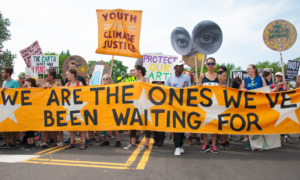
sdecoret/Shutterstock
.
I was recently interviewing a young person in a drop-in center serving people experiencing homelessness. While I have been working with this group of young people for almost a decade now, something about this interaction was especially poignant and jarring to me.
As a researcher, I collect data about people’s social relationships. In this particular instance, I had asked this youth to list five people she regularly communicated with. She could not come up with any names, even with a lot of prompting — none! In my years of interviewing young people, fortunately, there are very few young people who say they are not connected to any other human being.

Anamika Barman-Adhikari
Though this does not happen very often, it does ring some alarm bells. Homelessness is often characterized not just as a “poverty of economics” but also as a “poverty of relationships.” Ask any person, including yourself, who do you turn to at your most perilous moments? You might have taken this answer for granted, right? But for these vulnerable young people who are not just dealing with homelessness but all the other stressors that come with it, this question becomes all the more pertinent. The more important question here is — what can we do about it?
No young person should be homeless, especially in the richest country in the world. Yet, in any given year in the United States, approximately 3.5 million young adults ages 25 and younger experience homelessness. They often experience higher rates of victimization and trauma, sexual risk, discrimination and involvement in both the child welfare and the justice system compared to their housed peers.
Studies suggest that as many as 50% of young people experiencing homelessness have been involved in foster care, and more than 60% are or have been involved in the justice system. This is reflective of national trends among young adults regardless of their housing status: Although young adults comprise 10% of the U.S. population, they make up nearly 30% of arrests and about 20% of the incarcerated population. To most people who work with this group of young people, these numbers are disturbing, but not surprising.
Homeless but connected
Homelessness is a formidable and complex problem, and solutions, like the problem, also need to be multifaceted. While “housing first policies” are an obvious priority, in and of itself it is not enough to address youth homelessness. My colleague and I have worked with young people experiencing homelessness for several years.

Jaih Craddock
In our collective experience working with these young people, we have found that a majority of them are resilient, passionate and thoughtful young people who are clearly limited by their circumstances. Unlike how society stereotypes them, they are not all lazy, they are not all drug addicts and most importantly, no, they do not choose to live on the streets. A little compassion and empathy — while not enough — can go a long way in helping these young people.
All of which brings us back to our own research — the power of social relationships and how it can be leveraged to help young people facing homelessness. Homelessness is often characterized by social isolation, detachment from mainstream society and absence of a supportive social network. We know that social linkages are critical in helping people remain connected to the fabric of society and stay resilient in the face of adversity. Young people experiencing homelessness need the same kind of nurturing and positive relationships that other housed young people do, a fact that we continue to overlook.
The question is, what does the evidence tell us? Traditionally, we have tended to assume that these young people are confined to their street environments and engage only with other street-based youth, relationships that are important but not very resourceful. Research, however, suggests otherwise. Beyond their street connections, these young people are also connected to peers from home (i.e., friends they had before they became homeless), service providers, family members (e.g., parents, siblings and grandparents) among other types of relationships, relationships that help them stay connected to what we perceive as mainstream society — providing them much-needed resources and an opportunity to disengage from their street identities.
More importantly, maintaining connections with home-based peers and supportive family members has a positive function for most young people experiencing homelessness. A series of studies have found that homeless youth who connect with home-based, positive-role-modeling peers, family and case managers are more likely to use condoms, less likely to use drugs and alcohol, and less likely to experience depressive symptoms.
One of the biggest questions we often receive based on our research is: How are these young adults who are experiencing homelessness staying in contact with their non-street-based connections? Our research indicates that many of these connections are maintained via new forms of interactive and communicative technologies, such as social media and smartphones.
One would assume that if a person doesn’t have a roof over their head or know where the next meal is coming from, a smartphone and social media is the last thing on their minds. However, our research shows that not only is technology pervasive in their lives, it also plays a very important role in how these young people communicate, socialize and access resources.
Social media constructive
Multiple studies show that more than 80% of these youth have a Facebook profile, and approximately 60% have smartphones. Importantly, the use of social media and cellphones create a “bridge” for youth isolated from their families and friends and allows them to maintain relationships not connected with street life. Two studies have found that young people experiencing homelessness use social media and cellphones to connect with family, friends from home and caseworkers.
Having access to smartphones or the internet also enables youth to partake in goal-oriented activities, such as job, housing and health-related searches, all activities that provide opportunities for youth to successfully exit homelessness. Though not conventional, these technologies and the social capital that comes along with it are vital to the survival and success of youth experiencing homelessness.
Outside of youth using these new forms of technologies to access resources, research has shed light on the significant social influence social media interactions has on these young people. This work has indicated that youth experiencing homelessness who use social media to talk about safe sex, drug use and personal goals with home-based peers, parents, sexual partners or even staff members were more likely to adopt more protective behaviors and become more proactive about taking steps that would allow them to exit homelessness.
What does this all mean? That technology has the potential to be utilized in an effective manner to expand reach, foster engagement, increase access to services and relationships, and intervene in high-risk behaviors for this otherwise hard-to-reach population. Unfortunately, policies and services aimed at this population lack this relational or technological focus.
More importantly, linking young people to technology is almost an afterthought for most policymakers. The evidence, however, tells us otherwise. What we need is a more comprehensive, humane, innovative and relationship-oriented approach to service engagement. A recent meta-analysis, the gold standard when it comes to research evidence, found that youth mentoring has a significant impact on delinquency and associated outcomes for youth at risk for delinquency. However, mentoring hasn’t been widely used as a service modality for this group of young people.
New smartphone apps especially may be a critical part of a successful engagement strategy, although such strategies require a greater commitment to creating and maintaining the technologies. In the past few years, a few communities have designed smartphone apps specifically for youth who are homeless. Excellent examples of social service apps are Los Angeles’ WIN app and Pittsburgh’s Big Burgh app. However, these endeavors continue to be limited. Additionally, internet access for these young people is still elusive and while the digital divide has narrowed, it hasn’t yet been democratized.
In summary, relationships matter. This is especially true for youth who find themselves marginalized and detached from conventional society. By helping them connect to more positive people and support systems and resources, we truly believe we can help nurture their inner strength and change the trajectory of their lives. Technology, while not a panacea by itself, could provide a viable avenue through which we could intervene. So why are we waiting?
Anamika Barman-Adhikari, Ph.D., is an assistant professor at the Graduate School of Social Work at the University of Denver. Her research interests are broadly centered on understanding the social-contextual determinants of risk and protective behaviors among vulnerable populations, such as homeless and minority youth.
Jaih Craddock, Ph.D., is an assistant professor at the University of Maryland School of Social Work. Her work centers on understanding the associations between micro-level social interaction and macro-level behavioral health patterns and sexual health outcomes among vulnerable populations.































